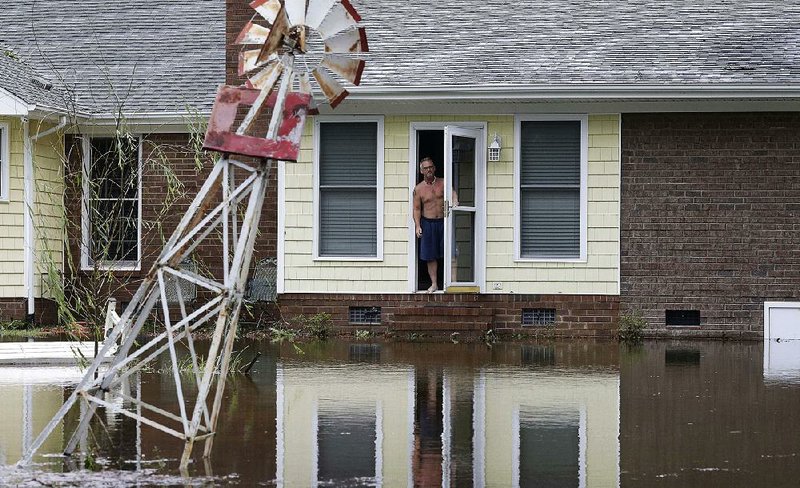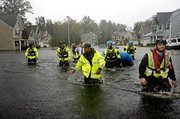WILMINGTON, N.C. -- Catastrophic flooding from Florence spread across the Carolinas on Sunday, with roads to Wilmington cut off by the epic deluge and muddy river water swamping entire neighborhoods miles inland. "The risk to life is rising with the angry waters," Gov. Roy Cooper declared as the storm's death toll climbed to 17.
The storm continued to crawl westward, dumping more than 30 inches of rain in spots since Friday, and fears of historic flooding grew. Tens of thousands were ordered evacuated from communities along the state's steadily rising rivers -- with the Cape Fear, Little River, Lumber, Waccamaw and Pee Dee rivers all projected to burst their banks.
In Wilmington, with roads leading in and out of the city underwater and streams still swelling upward, residents waited for hours outside stores and restaurants for basic necessities like water. Police guarded the door of one store, and only 10 people were allowed inside at a time.
Woody White, chairman of the board of commissioners of New Hanover County, said officials were planning for food and water to be flown into the coastal city of nearly 120,000 people.
"Our roads are flooded," he said. "There is no access to Wilmington."
State Transportation Secretary Jim Trogdon said the state was working with the Department of Defense and National Guard to see if they could get first responders through to Wilmington in high-water vehicles. He also said officials were working on "other contingencies to support Wilmington on the ocean side."
About 70 miles away from the coast, residents near the Lumber River stepped from their homes directly into boats floating in their front yards; river forecasts showed the scene could be repeated in towns as far as 250 miles inland as waters rise for days.
Downgraded overnight to a tropical depression, Florence was still enormous. But with radar showing parts of the storm over six Southeastern states and flood worries spreading into southern Virginia and West Virginia, North and South Carolina were still in the bull's-eye.
The storm has "never been more dangerous than it is right now," Cooper said at a news conference. "Wherever you live in North Carolina, be alert for sudden flooding."
All 100 counties in North Carolina had at least one type of National Weather Service alert, from a flash flood warning to a hazardous weather outlook, in effect for Sunday or the days ahead. Rain was expected to continue in parts of the state until Tuesday, but flooding on some rivers will last longer and may not ease until nearly the weekend.
South Carolina faced its own set of troubles, with its death toll rising Sunday and the storm's rains still unspooling havoc. Although Gov. Henry McMaster said flooding might continue in his state, he said he expected that South Carolina had "seen the end of the hurricane and most of the storm."
In North Carolina, fears of what could be the worst flooding in the state's history led officials to order tens of thousands to evacuate, though it wasn't clear how many had fled or even could. The head of the Federal Emergency Management Agency, Brock Long, said officials were focused on finding people and rescuing them.
"We'll get through this. It'll be ugly, but we'll get through it," Long told NBC's Meet The Press.
The slow-moving storm would be "dumping copious amounts of rains" on central and western North Carolina, he said, and "we're also anticipating you're about to see a lot of damage going through West Virginia all the way up to Ohio."
FEMA is monitoring the region's dams and has seen evidence that some have been "compromised," but the agency isn't aware of any life-threatening risks, Long said.
President Donald Trump said federal emergency workers, first responders and law enforcement officials were "working really hard." As the storm "begins to finally recede, they will kick into an even higher gear. Very Professional!" he declared in a tweet.
The storm's death toll climbed to at least 17 when a 3-month-old child was killed when a tree fell across a mobile home in North Carolina. Earlier, officials said three people died in separate, weather-related traffic accidents in South Carolina.
Victor Merlos was overjoyed to find a store open for business in Wilmington since he had about 20 relatives staying at his apartment, which still had power. He spent more than $500 on cereal, eggs, soft drinks and other necessities, plus beer.
"I have everything I need for my whole family," said Merlos. Nearby, a Waffle House restaurant limited breakfast customers to one biscuit and one drink, all take-out, with the price of $2 per item.
Kenneth Campbell had donned waterproof waders intending to check out his home in Lumberton, but he didn't bother when he saw the Coast Guard and murky waters in his neighborhood.
"I'm not going to waste my time. I already know," he said.
MANURE PERILS
As rivers swelled, state regulators and environmental groups were monitoring the threat from gigantic hog and poultry farms located in low-lying, flood-prone areas.
The industrial-scale farms contain vast pits of animal feces and urine that can pose a significant pollution threat if they are breached or inundated by floodwaters. In past hurricanes, flooding at dozens of farms also left hundreds of thousands of dead hogs, chickens and other decomposing livestock bobbing in floodwaters.
The state's 4,000 hog-manure lagoons are holding out, even though huge swaths of farmland in the state's eastern corner are underwater, Cooper said.
Hog farming is one of the biggest industries in North Carolina. Duplin County, where two people have died as a result of flash flooding, is home to 45 times as many hogs as its human population.
More than 10 billion pounds of wet animal waste is produced annually in the state, according to a June 2016 report by the Waterkeeper Alliance, a watchdog group. Environmental organizations are preparing to inspect waterways for toxic spills once the storm subsides. North Carolina has more hogs than any U.S. state other than Iowa.
"Rainfall amounts across the region have not exceeded the available capacity of farm lagoons on whole across the industry," the North Carolina Pork Council said in a statement posted to its website Saturday. "Lagoon levels were low ahead of the storm" after the waste was used as crop fertilizer, the group said.
Stream gauges across the region showed water levels rising steadily, with forecasts calling for rivers to crest Sunday and today at or near record levels. The Defense Department said about 13,500 military personnel had been assigned to help relief efforts.
Authorities ordered the immediate evacuation of up to 7,500 people living within a mile of a stretch of the Cape Fear River and the Little River, about 100 miles from the North Carolina coast. The evacuation zone included part of the city of Fayetteville, population 200,000.
Rainfall totals were stunning.
North Carolina's rainfall record from a tropical system already has been broken, with more than 30 inches of rain falling on Swansboro, surpassing the previous record set during Hurricane Floyd in 1999. But Cooper said Florence's strongest bands of rain were still pouring 2 or 3 inches an hour into some areas.
Twenty other places in North Carolina had at least 20 inches, according to the National Weather Service. Another 30 sites in North and South Carolina had at least 10 inches.
Water on the Cape Fear River near Chinquapin got so high that electronic instruments used to monitor flooding quit working after it became submerged, the U.S. Geological Survey said. The same thing happened on the Trent River.
Still, there was some good news: Power failures in the Carolinas and Virginia were down to about 580,000 homes and businesses after reaching a high of about 910,000 as the hurricane plowed into the coast. Utilities said some outages could last for weeks.
In Goldsboro, N.C., home of Seymour Johnson Air Force Base, roads that frequently flood were already closed Saturday by rushing water. Dozens of electric repair trucks massed to respond to damage expected to hit central North Carolina as rainwater collected into rivers headed to the coast.
Duke Energy said heavy rains caused a slope to collapse at a coal ash landfill at a closed power station outside Wilmington late Saturday, but there was no indication contamination had drained into the nearby Cape Fear River. The company initially estimated that about 2,000 cubic yards of ash were displaced at the landfill, enough to fill about 180 dump trucks. Authorities said that estimate could be revised.
Near the flooded-out town of New Bern, where about 455 people had to be rescued from the swirling flood waters, water completely surrounded churches, businesses and homes.
The rain was unrelenting in Cheraw, a town of about 6,000 people in northeastern South Carolina. Streets flooded and Police Chief Keith Thomas warned people not to drive, but the local food and gas store had customers.
"As you can tell, they're not listening to me," he said.
Information for this report was contributed by Chuck Burton, Alex Derosier, Jonathan Drew, Allen G. Breed, Emery P. Dalesio, Denise Lavoie, Sarah Rankin, Gary Robertson, Martha Waggoner, Meg Kinnard, Jeffrey Collins, Russ Bynum, Seth Borenstein, Michael Biesecker, Lolita C. Baldor, Jennifer Kay and Jay Reeves of The Associated Press; by David Zucchino, Alan Blinder and Jack Healy of The New York Times; and by Olivia Carville, Megan Durisin, Ben Brody and Anna Edney of Bloomberg News
RELATED ARTICLE
https://www.arkansa…">FEMA director disputes study of island deaths
A Section on 09/17/2018

